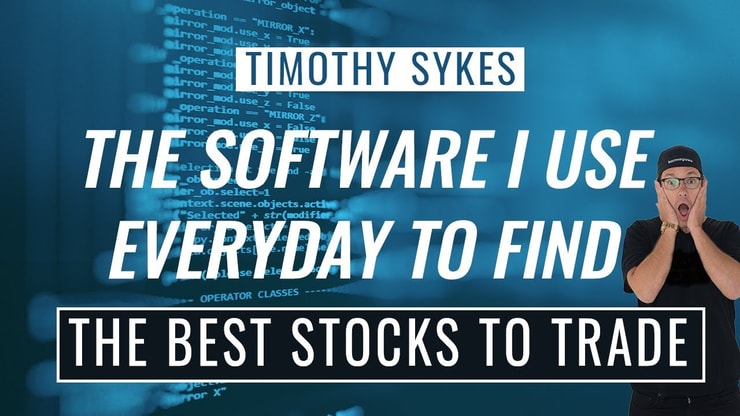In the trading world, where information is king, stock scanners are your eyes and ears. Too many traders don’t know this — which is like trying to trade with one eye closed.
But what are stock scanners, and how can you use them to improve your trading?
There are dozens out there, both free and paid … which is right for you? Let’s dive in and find out.
Table of Contents
- 1 What are Stock Scanners? A Quick Overview
- 2 Exploring the Benefits of Using Stock Scanners for Trading
- 3 Classifying Stock Scanners: A Closer Look
- 4 A Step-by-Step Guide to Using a Stock Scanner for Trading
- 5 Determining the Criteria for Good Scan Results
- 6 Key Takeaways on Using Stock Scanners for Trading
What are Stock Scanners? A Quick Overview

2025 Millionaire Media, LLCStock scanners, also known as stock screeners, are powerful tools that traders use to filter through thousands of stocks in the market. They’re like a search engine for stocks, allowing you to input specific criteria such as price, volume, and market cap to find trading opportunities that match your strategy.
For example, if you’re a day trader looking for volatile stocks, you might set your scanner to find stocks with high trading volume and significant price movements. On the other hand, if you’re a long-term investor, you might use a scanner to find companies with strong fundamentals and steady growth.
As you delve deeper into the world of trading, it’s crucial to familiarize yourself with the tools that can streamline your process. One tool that your scanner should have is hot keys, which can significantly enhance your trading efficiency by allowing you to execute trades quickly and accurately. Hot keys are customizable keyboard shortcuts that can be set up on your trading platform to perform various actions, such as buying or selling a stock, cancelling orders, or even setting stop losses. This can be particularly useful in fast-paced trading environments where speed is of the essence.
To learn more about how hot keys can improve your trading experience, check out this comprehensive guide on hot keys.
Exploring the Benefits of Using Stock Scanners for Trading
Stock scanners offer a range of benefits for traders. First and foremost, they save you time. Instead of manually sifting through data and charts for thousands of companies, you can use a stock scanner to do the heavy lifting. This allows you to focus on analysis and strategy, rather than data collection.
Second, stock scanners provide a level of precision that’s hard to achieve manually. By setting specific criteria, you can find exactly the kind of stocks you’re interested in, whether that’s small-cap tech companies with high growth potential or blue-chip stocks with stable dividends.
While stock scanners are a powerful tool in their own right, they are most effective when used in conjunction with a reliable trading platform. A good trading platform will not only provide you with a robust stock scanner but also offer other essential features such as real-time quotes, advanced charting tools, and a user-friendly interface.
It’s also important to choose a platform that suits your specific trading style and needs. For instance, day traders might prefer a platform with fast execution speeds and low fees, while long-term investors might prioritize a platform with extensive research tools and a wide range of investment options. To help you make an informed decision, here’s a detailed review of some of the best trading platforms for day traders.
Classifying Stock Scanners: A Closer Look
There are several types of stock scanners, each with its own advantages and features.
There’s one stock scanner that I use in every situation…
StocksToTrade is a stock scanner that integrates with most major brokers. I helped to design it, which means it has all the stock screening capabilities that traders like me look for in a platform.
I also use StocksToTrade to scan for news, tweets, earning reports, and more — all covered in its powerful news scanner.
Grab your 14-day StocksToTrade trial today — it’s only $7!
Just because it’s the best scanner for traders like me doesn’t mean it’s the best scanner for you. Here are some of the different stock scanners you can use:
Fundamental Criteria-Based Scanner: Unraveling the Essentials
Fundamental criteria-based scanners allow you to search for stocks based on fundamental analysis metrics such as earnings per share (EPS), price-to-earnings (P/E) ratio, and dividend yield. These scanners are particularly useful for long-term investors who base their decisions on a company’s financial health and growth prospects.
Technical Criteria-Based Scanner: A Technical Perspective
Technical criteria-based scanners, on the other hand, focus on technical analysis indicators like moving averages, support and resistance levels, and MACD. These scanners are a favorite among day traders and swing traders who rely on chart patterns and technical indicators to make their trading decisions.
More Breaking News
- Webull Corporation’s Stock Skyrockets: What’s Driving the Surge?
- Symbotic Inc. Gains Momentum
- AES Shares Surge: Analyzing Recent Developments
Real-Time Scanner: Embracing the Speed
Real-time scanners are a boon for day traders. These tools scan the market in real-time, providing up-to-the-minute information on price movements, trading volume, and other key metrics. This allows traders to react quickly to market changes and seize trading opportunities as they arise.
Intraday Stock Scanners: Making the Most of Market Hours
Intraday stock scanners focus on the action happening during market hours. They’re designed to help day traders find stocks that are moving significantly during the day, based on criteria like volume spikes, price changes, or breaking news events.
Post-Market Stock Scanners: Leveraging After-Hours Opportunities
Post-market stock scanners, as the name suggests, are used to scan the market after the regular trading hours have ended. They’re useful for identifying stocks that have made significant moves in the after-hours market, which can often be a precursor to movements during the next trading day.
A Step-by-Step Guide to Using a Stock Scanner for Trading

2025 Millionaire Media, LLCHere are the steps to scanning with purpose! Over my 20-plus-year trading career, I’ve done all the research…
Here are my best tips, in numbered order:
Step 1: Choosing the Appropriate Stock Scanner: Factors to Consider
Choosing the right stock scanner is crucial. Consider factors like:
- Features
- Cost
- Add-on products and services
- Performance
- Does it have a website, desktop platform, and/or mobile app? This can make a real difference for your stock scanner strategy
For me, the choice is easy in any situation…
Step 2: Identifying Your Investment Goals and Trading Strategies
Before you start scanning, it’s important to have a clear idea of your investment goals and trading strategy. Are you a day trader looking for short-term price movements? Or a long-term investor seeking steady growth? Your goals will determine the criteria you set in your scanner.
Step 3: Selecting the Appropriate Parameters to Set the Criteria for Your Search
The parameters you set in your scanner should align with your trading strategy. For instance, if you’re looking for momentum trades, you might set your scanner to find stocks with high trading volume and significant price changes. If you’re a swing trader, you might look for stocks with certain candlestick patterns or Fibonacci retracements.
Determining the Criteria for Good Scan Results

2025 Millionaire Media, LLCAs you refine your scanning criteria and start identifying potential trading opportunities, it’s important to have a solid understanding of the basics of day trading. This includes knowledge of different trading strategies, risk management techniques, and the ability to analyze market trends and indicators. Day trading is a skill that requires practice and continuous learning, but with the right approach, it can be a profitable venture.
If you’re new to day trading or looking to brush up on your skills, this guide on day trading basics is a great place to start.
The markets will be the ultimate judge, mind you…
Make sure you have the following content in place before you try anything involving real money!
Parameter and Trigger Settings: A Guide to Precision
Setting the right parameters and triggers in your stock scanner is key to getting useful results. This involves specifying the criteria that a stock must meet to be included in your scan results. For example, you might set a parameter for stocks with a market cap above a certain threshold, or a trigger for stocks that have crossed a specific moving average.
Quality Over Quantity: Why it Matters
When it comes to scan results, quality trumps quantity. It’s better to have a handful of stocks that precisely meet your criteria than a long list of loosely fitting candidates. This is where the precision of your parameter and trigger settings comes into play. The more specific your criteria, the more targeted your results will be.
Segment Custom Scans to Your Niche: A Tailored Approach
Customizing your scans to fit your niche can significantly enhance your trading efficiency. For instance, if you specialize in trading tech stocks, you might set your scanner to focus on the Nasdaq. Or if you’re interested in small-cap stocks, you might set a parameter for companies with a market cap below a certain level.
Scanning for Stocks with Significant Price Movements: An Effective Strategy
One effective strategy for using stock scanners is to scan for stocks with significant price movements. This can help you spot potential trading opportunities. For example, a sudden spike in trading volume could indicate that a stock is about to break out, while a significant price drop could present a buying opportunity.
Key Takeaways on Using Stock Scanners for Trading

2025 Millionaire Media, LLCStock scanners are powerful tools that can save you time, provide precision, and enhance your trading efficiency. By understanding how to use them effectively, you can find high-quality trading opportunities that align with your strategy.
Trading isn’t rocket science. It’s a skill you build and work on like any other. No matter the goals you have in mind, smart trading can help you get there. Trading has changed my life, and I think this way of life should be open to more people…
I’ve built my Trading Challenge to pass on the things I had to learn for myself. It’s the kind of community that I wish I had when I was starting out.
We don’t accept everyone. If you’re up for the challenge — I want to hear from you.
Apply to the Trading Challenge here.
Trading is a battlefield. The more knowledge you have, the better prepared you’ll be.
What scanner do you use? Let me know in the comments — I love hearing from my readers!











Leave a reply